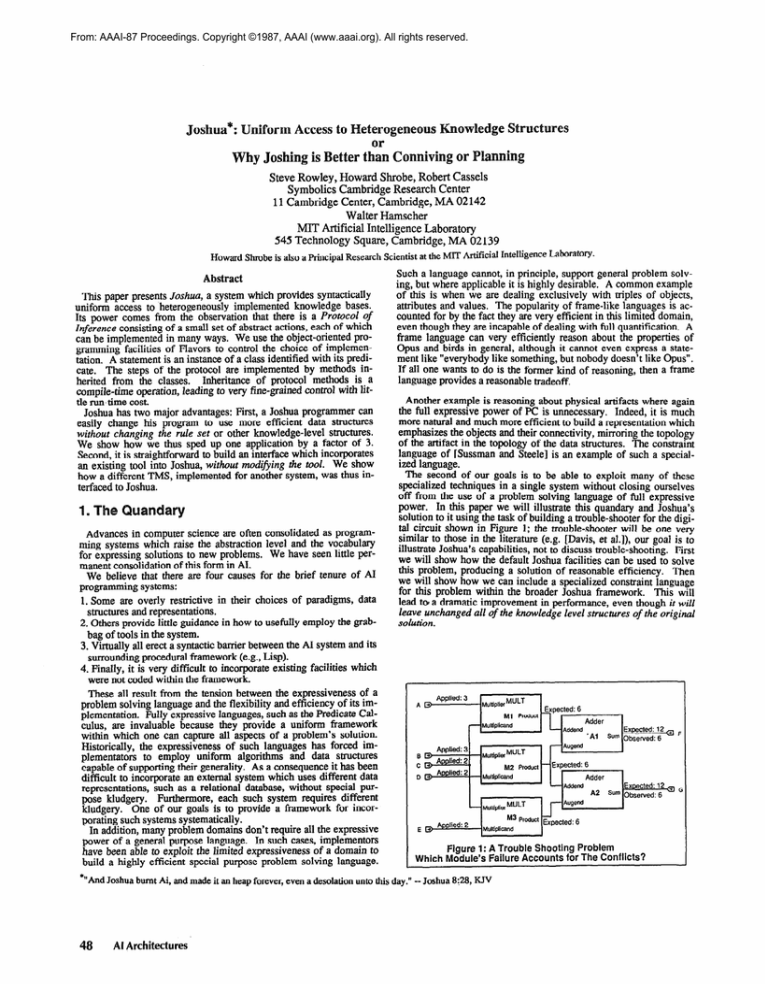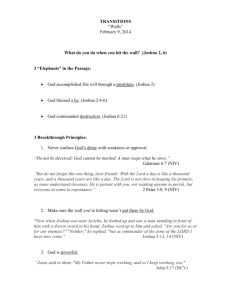
From: AAAI-87 Proceedings. Copyright ©1987, AAAI (www.aaai.org). All rights reserved.
Joshua*: Uniform Access to Heterogeneous
Why Joshing is Better tlin
Knowledge Structures
Conniving or Phming
Steve Rowley, Howard Shrobe, Robert Cassels
Symbolics Cambridge Research Center
1 II Cambridge Center, Cambridge, MA 02142
Walter Hamscher
MIT Artificial Intelligence Laboratory
545 Technology Square, Cambridge, MA 02139
Howard Shrobe is also a Principal Research Scientist at the MIT Artificial Intelligence LaboratorY*
Abstract
This paper presents Joshua, a system which provides syntactically
uniform access to heterogeneously implemented knowledge bases.
Its power comes from the observation that there is a Protocol of
Inference consisting of a small set of abstract actions, each of which
can be implemented in many ways. We use the object-oriented programming facilities of Flavors to control the choice of implementation. A statement is an instance of a class identified with its predicate. The steps of the protocol are implemented by methods inInheritance of protocol methods is a
herited from the classes.
compile-time operation, leading to very fine-grained control with little run-time cost.
Joshua has two major advantages: First, a Joshua programmer can
easily change his program to use more efficient data structures
without changing the rule set or other knowledge-level structures.
We show how we thus sped up one application by a factor of 3.
Second, it is straightforward to build an interface which incorporates
an existing tool into Joshua, without modijjGng the tool. We show
how a different TMS, implemented for another system, was thus interfaced to Joshua.
1.-r
uandary
Advances in computer science are often consolidated as programming systems which raise the abstraction level and the vocabulary
for expressing solutions to new problems. We have seen little permanent consolidation of this form in AI.
We believe that there are four causes for the brief tenure of AI
programming systems:
1. Some are overly restrictive in their choices of paradigms, data
structures and representations.
2. Others provide little guidance in how to usefully employ the grabbag of tools in the system.
3. Virtually all erect a syntactic barrier between the AI system and its
surrounding procedural framework (e.g., Lisp).
4. Finally, it is very difficult to incorporate existing facilities which
were not coded within the framework.
These all result from the tension between the expressiveness of a
problem solving language and the flexibility and efficiency of its implementation. Fully expressive languages, such as the Predicate Calculus, are invaluable because they provide a uniform framework
within which one can capture all aspects of a problem’s solution.
Historically, the expressiveness of such languages has forced implementators to employ uniform algorithms and data structures
capable of supporting their generality. As a consequence it has been
difficult to incorporate an external system which uses different data
representations, such as a relational database, without special purpose kludgery. Furthermore, each such system requires different
kludgery. One of our goals is to provide a framework for incorporating such systems systematically.
In addition, many problem domains don’t require all the expressive
power of a general purpose language. In such cases, implementors
have been able to exploit the limited expressiveness of a domain to
build a highly efficient special purpose problem solving language.
*“And Joshua bmt
4%
Such a language cannot, in principle, support general problem solving, but where applicable it is highly desirable. A common example
of this is when we are dealing exclusively with triples of objects,
attributes and values. The popularity of frame-like languages is accounted for by the fact they are very efficient in this limited domain,
even though they are incapable of dealing with full quantification. A
frame language can very efficiently reason about the properties of
Opus and birds in general, although it cannot even express a statement like “everybody like something, but nobody doesn’t like OPUS”.
If all one wants to do is the former kind of reasoning, then a frame
language provides a reasonable tradeoff.
Another example is reasoning about physical artifacts where again
the full expressive power of PC is unnecessary. Indeed, it is much
more natural and much more efficient to build a representation which
emphasizes the objects and their connectivity, mirroring the topology
of the artifact in the topology of the data structures. The constraint
language of [Sussman and Steele] is an example of such a specialized language.
The second of our goals is to be able to exploit many of these
specialized techniques in a single system without closing ourselves
off from the use of a problem solving language of full expressive
power. In this paper we will illusa-ate this quandary and Joshua’s
solution to it using the task of building a trouble-shooter for the digital circuit shown in Figure 1; the trouble-shooter will be one very
similar to those in the literature (e.g. [Davis, et al.]), our goal is to
illustrate Joshua’s capabilities, not to discuss trouble-shooting. First
we will show how the default Joshua facilities can be used to solve
this problem, producing a solution of reasonable efficiency. Then
we will show how we can include a specialized constraint language
for this problem within the broader Joshua framework. This will
lead tot a dramatic improvement in performance, even though it will
leave unchanged all of the knowledge level structures of the original
solution.
A
F
-I
E
l
Applied: 2
-
Figure 1: A Trouble Shooting’Problem
Which fulodule’s Failure Accounts for The Conflicts?
Ai, and made it an heap forever, even a desolation unto this day.” -- Joshua 8%
Al Architectures
M3 product Expected: 6
Multiplicand
KJV
Zncrementality that the effort required to effect a modification of
behavior should be proportional to the size of the changed behavior.
These features allow Joshua to incorporate outside tools easily and
use specialized representations where desirable. In the rest of this
First, we will show a
paper we will illustrate these points.
straightforward Joshua implementation of a digital trouble-shooter
which is reasonably efficient. However, a solution using a constraint
language approach would greatly improve the efficiency. To see
how such a representation can be incorporated, we will present the
Protocol of Inference in some detail. Then we will show that to
incorporate this alternative implementation we will only have to
provide a few protocol methods. We will modify no knowledgelevel structures of our original implementation.
Finally, we will
present a brief example of how Joshua can incorporate tools built
outside the Joshua framework.
Joshua solves the problem using the abstraction power of the Lisp
programming environment. In particular, it relies on the objectoriented facilities of Flavors, although the facilities of the emerging
Common Lisp object-oriented programming standard would serve as
well. The main features of Joshua are:
0 There is a Uniformly Accessible but Heterogeneous Data Base
of Statements. Two Lisp forms, ASK and TELL, provide the interface to this database. ASK queries the data base, finding facts
which explicitly match the query as well as those implied by backward chaining rules and other inferential capabilities. TELL inserts
a statement and computes its consequences by invoking forward
chaining rules and other inferential capabilities. ASK and TELL may
implement their behavior in any manner desired and the statements
may be represented using a variety of different data structures. The
contract of ASK and TELL is functional, not implementational.
e There is a Fine-Grained Protocol of Inference in which each distinct step of processing a statement is identified and made accessible. This protocol is hierarchical as well as fine-grained. ASK,
TELL, rule compilation, rule triggering and truth maintenance are
all parts of this protocol as are their component steps. To use a
novel set of data structures, for example, one needs to change only
a few, small steps of the protocol.
8)Each step of the protocol is 8 Generic Function, i.e., an abstract
procedure whose concrete implementation is found by dispatching
on the data types of its arguments. The generic functions are implemented using object-oriented programming techniques (in particular Flavors). Statements are regarded as instances. Predicates
are identified with the classes. The protocol steps are implemented
as methods.
@There is a modular inheritance scheme which allows facilities
to be identified and reused. The classes corresonding to predicates are the leaves of an inheritance lattice. A more abstract class
in this lattice is thought of as a model for implementing part or all
of the protocol, supplying Methods only for those few protocol
steps that it handles in a unique way. Inheritance of methods happen at compile time; there is no run-time cost.
QThere is a wellll-craned default implementation of each step of the
protocol provided in the system. However, the protocol is hierarchical, so modifications can be focused on lower level protocol
steps, preserving the gross structure. Most models continue to use
most of the default methods, thus satisfying the Principle of
(DEFRULE ADDER-FORWARD
(:FORWARD
:IMPORTANCE
1)
;; Compute adder output from inputs
IF [AND [TYPE-OF EA ADDER-BOX)
[STATUS-OF
=A WORKING]
[VALUE-OF
INPUT A =A =Vll
[VALUE-OF
INPUT B =A =V211
THEN (TELL '[VALUE-OF
OUTPUT SUM ,HA ,(+ =vI
Joshua’s syntax is uniform and statement-oriented; statements are
delimited by brackets and variables are indicated by a leading equivalence sign. Free variables are, as usual, universally quantified. The
core of Joshua is provided by the two generic functions TELL and
ASK. TELL adds a statement to the data base of known facts and then
performs whatever antecedent inferences are possible. ASK takes
two arguments, the first of which is the query; the second argument,
called the continuation, is a function which is called in a binding
context created by unifying the query and matching statements. The
continuation is called once for each statement satisfying the query
whether this statement is explicitly present or is deduced. Many of
Joshua’s deductive capabilities are built using forward and
backward-chaining rules. A Truth Maintenance System provides the
ability to make and retract assumptions, to explain the reason for
believing any statement, or to find the set of statements supporting
any conclusion in the database.
Figure 2 shows how one would use Joshua to build a hardware
trouble-shooting
system similar to those in [Davis et al.],
[Genesereth] or [deKleer & Williams]. A simulator for the circuit is
built by defining rules which describe adders, multipliers, and wires
and then by executing a Lisp procedure which TELLS what components are present and how they are connected. A simulation is run
by providing initial values for the inputs of the circuit. A backwardchaining rule captures the notion of a conflict, a point in the circuit at
which the predicted and observed values disagree. The troubleshooter’s goal is to find all modules in the circuit whose failure could
plausibly account for each conflict. This is done in the procedure
FIND-CANDIDATES which uses the TMS to find the intersection of the
sets of assumptions supporting each conflict.
DEFRULE
DETECT-TERMINAL-CONFLICT
(:BACKwARD)
;; Infer a conflict from difference of
;; observed and simulated values.
IF
=v2)1))
(DEFRULE MULTIPLIER-INFERENCE
(:FORWARD)
;; Compute multiplicand from product
[AND
THEN
[OBSERVED-VALUE-OF
=TERMINAL
=OBJECT
sOBSERVED
[VALUE-OF
~TERMINAL
SOB-CT
Z~COMPUTED-VALUE)
(# =OBSERVED-VALUE
=COMPUTED-VALUE)
1
[CONFLICT-AT
STERMINAL
EOBJECT
aOBSERVED-VALUE
=COMPUTED-VALUE])
lDEFUN FIND-CANDIDATES
()
.a and multiplier by dividing
.- find candidates that explain allthe conflicts
;F
&T
(AND
THEN
[TYPE-OF
=M MULTIPLIER)
[STATUS-OF
EM WORKING]
[VALUE-OF PRODUCT
=M
=VI]
[VALUE-OF MULTIPLIER
=M
=v211
(UNLESS (= 0 =V2)
(TELL '[VALUE-OF
MULTIPLICAND
,=M
((SUPPORT-SETS
(ASK [CONFLICT-AT
#'(LAMBDA
,(/
=VI
;; for each conflict derived,
.a record its set of supporting assumptions
=v2)))))
&JSH
(DEFRULE
WIRE
(:FORWARD
:IMPORTANCE
2)
;; Compute value at one end of a wire from
;; the value at the other end
IF [AND [WIRE ETERMINAL~ =OBJECT~ rTERMINAL2 =oBJEcT~I
THEN
[VALUE-OF
ETERMINAL~
ZOBJECT~
EVALUE))
=TERMINAL2
mOBJECT2
=VALUE])
[VALUE-OF
(DEFUN SIMULATE
()
(TELL [VALUE-OF A pl 31)
(TELL [VALUE-OF B PI 21)
. . .)
NIL))
ZTERMINAL
EOBJECT
EOBSERVED-VALUE
=COMPUTED-VALUE]
(CONFLICT)
(SUPPORT
CONFLICT
:ASSUMPTION)
SUPPORT-
;: now take the intersection of all such sets
(APPLY
#'INTERSECTION
SUPPORT-SETS)))
(DEFUN SETUP
()
(TELL [TYPE-OF Ml MULTIPLIER])
:JUSTIFICATION
(TELL [STATUS-OF
MI WORKING)
;&LL
[WIRE
OUTPUT
PRODUCT
Ml INPUT ADDEND
'ASSUMPTION)
All))
igure 2: Joshua Code for The Trouble Shooter
Rowley, Shrobe, Cassels, and Hamscher
49
Joshua provides well-crafted default implementations for all of its
standard facilities. Discrimination networks are used for data and
rule indexing. Forward chaining rules use a Rete network IForgy] to
merge the bindings from matching the separate trigger patterns.
There is a rule compiler that transforms the rule’s patterns and actions into Lisp code. Using these default facilities, we achieve a
rule-firing rate of about 120 rules/second while running the troubleshooting example on a Symbolics 3640. This is comparable with
other well-implemented tools.
3.1. The Probkm
Joshua maintains several internal meters, one of which indicates
that during the execution of the trouble-shooting procedure the Rete
Network’s efficiency was only 5%. This means that the system
wasted a lot of effort trying to trigger rules. One reason for this is
clear: The WIRE rule contains two trigger patterns, each of which
contains only variables. This means that the Rete network will try to
merge every WIRE statement with every VALUE-OF statement, failing
in most cases. There are several other mismatches between the
problem and the implementation structure. The uniform statementoriented syntax of Joshua is a reasonable means for expressing the
problem solving strategy. However, the statement-oriented indexingscheme needed to support this expressive generality provides a poor
implementation for our specific problem since it cannot exploit its
constraints.
A constraint language framework like that in [Davis & Shrobe]
which uses data structures mirroring the connectivity and topology of
the circuit would better exploit the limitations of our problem
domain. However, we want to avoid changing our rules or our
trouble-shooting procedures since these constitute the “knowledge
level” of the program. Finally, we want to avoid writing a large
amount of code simply to take advantage of an existing set of data
structures. The key to achieving all three of our goals simultaneously is Joshua’s Protocol of Inference.
4. The
Protocol
of inference
The structure of the Protocol is shown in Figure 3; each step of the
protocol corresponds to a generic function that dispatches on the type
of the statement being processed. We implement each statement as a
Instance of a class, where the class corresponds to the Predicate of
the statement. The classes are organized in an inheritance lattice
with each class providing some protocol methods and inheriting
others from more abstract classes. (In our current implementation,
the classes are flavors and the statements are flavor instances).
For example, the statement [VALUE-OF ADDEND Al lo] is an inStanCe of the VALUE-OF class; this class inherits from the class for
PREDICATION (all statements inherit from this class); in the default
implementation it also inherits from the DN-MODEL class which
provides discrimination-network data indexing. 7%e PREDICATION
Telk installs new information.
o Justify:the interfaceto the TMS.
0 Insert:manages the actualdata indexing.
Map-Over-Forward-Triggers:
findsand invokes rules.
Locate-Trigger:managesthe indexing to locate relevantrules.
e Ask retrievesknown or implied data.
0Fetch: managesthe data indexing to find statementswhich might unify
with the query
*Map-Over-Backward-Triggers:
finds and runs relevantrules.
0 Locate-Trigger:manages the indexing to locate relevantrules.
l
l
l
0
Protocol:ManagesDeductiveDependencies
Justify:instaRsa newTMSjustification
TMS
l
0 Notice-Truth-Value-Change:allows special processing when statements
change truthvalue.
Retract:removes a justification.
a Notice-Truth-Value-Change:
as above.
0 Explain:printsan explanationof the reason for believing a statement.
Support:finds the set of facts or assumptionsthat a statementdependson.
l
I
50
class provides the gross structure of the ASK and TELLprotocol steps
in its ASK and TELL methods. The DN-MODEL class provides a
specific kind of data indexing by supplying methods for the INSERT
and LOCATE-TRIGGERprotocol steps which determine where data and
rules are stored.
‘Ihe generic function for each protocol step dispatches on the type
of a statement to determine, using the inheritance lattice, which
method to run. For example, the generic function for the TELL
protocol step when applied to the predication [VALUE-OFADDENDAl
lo] executes the TELLmethod inherited from the PREDICATION
class.
This TELL method calls several other generic functions, in particular
the one for the INSERT protocol step. ‘Ihis method is inherited from
the more specific DN-MODEL class. In the Flavors implementation
used by Joshua, inheritance is a compile-time operation which incurs
no run-time cost.
The Protocol
has major steps
for TELL, ASK, the
TRUTH-MAINTENANCE entry points, and RULE-COMPILATION;it has
minor steps corresponding to the details of how each of the major
actions is performed. For example, TELLis concerned with installing
new information. Its components are JUSTIFY,which is the interface
to the TMS, INSERT, which manages the actual data indexing, and
MAP-OVER-FORWARD-TRIGGERS which invokes forward-chaining
This, in turn, relies on the
rules using the Rete network.
LOCATE-TRJGCER
protocol step which manages the indexing of rules.
The advantage of exposing this structure is modularity: If one only
wants to modify how the data is indexed, one doesn’t have to
reimplement all the behavior of TELL. Instead one need only provide
a new INSERT method; the rest of the behavior can be inherited from
the defaults provided with the system. If one wants to modify how
rules are indexed, one only has to provide a LOCATE-TRIGGER
method. ‘I’he implementor should define these methods at a place in
the lattice of classes so that only the desired statements inherit the
new behavior.
If, for example, there is a specialized indexing
scheme which works well for a restricted class of statements we can
easily make that set of statements take advantage of the technique,
while all other statements continue to use the more general techniques provided as the system default.
The
of Inference
Figure 4 shows an implementation technique for the troubleshooting example which is similar to those used for constraintlanguages. These structures can be thought of as a set of frames and
slots. The frames are used to represent objects, e.g. ADDER-~, and
classes of objects, e.g. ADDER. The slots are used to represent terminals, e.g. the ADDENDof ADDER-l;the facets of the slot are used to
represent the value of the signal present at the terminal, the set of
other terminals wired to it an&the set of relevant rules.
= Rule Indexing Protocol
Add-Forward-Trigger
Remove-Forward-Trigger
* Add-Backward-Trigger
* Remove-Backward-Trigger
0 Trigger-Location:used by all four of the above.
0 Rule CustomizationProtocol
*Compile-Forward-Trigger:the hook to provide your own matcher for a
forward-chainingrule.
* Positions-Matcher-Can-Skip:informs the match compiler that the data
indexing scheme guarantees that certain positions of the statement already match the pattern,so thatless matchcode can be generated.
* Compile-Backward-Trigger:
same for backward-chainingrules.
0 Positions-Matcher-Can-Skip:
as above.
0 CompileForward-Action: tailors the behavior of a statementin the THEN
part of a forward-chainingrule.
* Compile-Backward-Action:tailors the behaviorof a statementin the IFpart
of a backward-chainingrule.
l
l
l
Figure 4: The Protocol sf inference
Al Architectures
Protocol
This representation exploits the object-oriented nature of the
problem in several ways: First, the topology of the data structures is
identical to that of the circuit; to find what other terminals are connected to the ADDENDof ADDER-~one only need fetch the WIRES
facet of the terminal. Second, facts are indexed locally. To find the
value of the signal at the ADDENDof ADDER-I, one need only find
ADDER-I and then find its ADDENDslot Third, rules are indexed
To find a rule which is triggered by the statement
locally.
[VALUE-OFADDENDAl 101,one only need find the Al frame, follows
its AKQ link to the class ADDER,and then find ADDER'S addend slot.
Thus, to add or retrieve information or to draw an inference one need
only follow a small number of pointers. ln particular, notice that
wires are represented by direct links between connected terminals,
instead of the troublesome WIRE rule shown in Figure 2. These data
structures can be implemented easily using a frame-like subsystem
provided with Joshua’.
However, let us imagine that we already have an implementation of
a constraint language and then consider what we would need to do to
make Joshua able to incorporate it. The trouble-shooting program
has two broad categories of statements: The first category consists
of TYPE-OF,and WIREstatements which describe the topology of the
circuit.
The second category
includes
VALUE-OF and
OBSERVED-VALUE-OF
statements which carry information about the
value (or inferred value) of signals in the circuit. CONFLICT-AT
statements also fall in the category, since they capture a discrepancy between the predicted and observed values.
The trouble-shooting program is primarily an antecedent reasoning
system, so our attention will be focused on what methods we need to
provide for the component steps of the TELL protocol. For the first
category of statements our strategy will be as follows: When we
TELL a TYPE-OFstatement, e.g. [TYPE-OFAI ADDER],we will build a
frame representing Al that is an instance of the ADDERframe. This
frame has slots for each of Al’s terminals, and each of these has
several facets, one of which is the WIRES facet. When we TELL a
WIRE statement, e.g. lWIREPRODUCTMl ADDENDAl], we will add
pointers to the WIRESfacet of both mentioned terminals so that the
PRODUCTof Ml points to the ADDENDof AI and vice versa. The
INSERT protocol method is the right level of the TELL protocol to
control this. Similarly, we only need to provide an INSERTmethod
for WIREstatements which updates the WIRESfacet of the appropriate
slot. Also for each of these statement types we provide a FETCH
method (the step of the ASK protocol responsible for locating the
data) so that we can retrieve the data. Other than this, all processing
of these statements uses the provided facilities.
The second category of statements deals with signal values. Our
strategy for these is as follows: We will store VALUE-OF and
OBSERVED-VALUE-OFstatements
in the appropriate
named
TERMINALof the circuit; to do this we need only provide an INSERT
protocol method for VALUE-OFand OBSERVED-VALUE-OF
statements.
Since the constraint-language provides a means for locating a named
terminal, we need only have our protocol method call this procedure.
1FOPsoace reasons. we won’t discuss theJoshuaflavor-basedframe svstem here
falue-of Addend Al 5)
/
2
(Type-of Al Adder)
Addend Terminal
I
puts the value here
Figure 4: Constraint-Language Style of Implementation
In addition, we want to store our rules locally; for example, a rule
about adders with the pattern [VALUE-OF5 ADDEND= Al = VJ, should
store its trigger in the FWRD-RULESfacet of the ADDENDslot of the
ADDER frame.
To do this we only need to provide a
LOCATE-TRIGGERSprotocol method.
The LOCATE-TRIGGERS
protocol method is used by the protocol steps for installing rules and
for fetching them; thus this one modification changes the complete
rule data indexing scheme for this type of statement.
.I.
nin
These data structures can perform certain deductions far more efficiently that can our rules. Since the data structures exactly mirror
the topology of the wires in the circuit being modelled we should use
them to model the propagatation of signals along wires. To do this,
we only need to add a small amount of code to the INSERTmethod
for VALUE-OFand OBSERVED-VALUE-OF
statements. This code examines the WIRES facet of the terminal mentioned in the statement
and then propagates the information to the connected terminals, by
TELLing a new statement describing the value at the connected terminal. For example, suppose we TELL the system that the value of
the PRODUCTof Ml is 6, and this terminal is connected to the
ADDENDof Al. The INSERTprotocol method for VALUEGF statements, will then TELLthe system that the value of the ADDENDof Al
is also 6. (The reason this doesn’t create an infinite loop is that part
of the contract for INSERTmethods is that they must first check to see
if the data is already present; if so they must simply return the stored
data).
CGNFLICT-ATstatements are also more efficiently deduced within
the model. A CONFLICT-AT
statement should be deduced anvtime_ the
-_VALUE and ‘OBSERVED-VALUE
at a terminal disagree. To’perform
this inference, we again add code to the INSERTprotocol method for
each of these statements; this checks to see if we know both the
VALUE and OBSERVED-VALUE
at this terminal. If so, and if they
disagree, then we TELLthe appropriate CONFLICT-AT
statement.
.a.
strai
In summary, our system now has the following specialized behavior. When we make an assertion about the TYPE-OFan object, we
create a representation of this object and its electrical terminals. This
representation is situated in a taxonomic hierarchy below the node
representing its type. For example, (TELL HYPE-OF Al ADDER])
creates an object of type ADDERand names it Al. When we TELL
that a wire connects two terminals, we update facets of their corresponding TERMINALsso that they contain direct pointers to each
other. When we make a statement about the value ata terminal (e.g.,
[VALUE-OFADDENDAl 21), we locate the terminal data structure by
first locating the object Al and then finding the terminal named
ADDEND. This terminal has direct pointers to all the other terminals
that are connected to it, so we just follow these pointers and update
the value at these other terminals as well. For each terminal that we
update, we find the rules which might trigger by looking in the
FWRD-RULESfacet.
The whole system behaves like a constraint propagation system.
However, it is not just behaving like a constraint propagator, it is a
constraint propagation system embedded in the more general Joshua
framework. Incorporating this constraint propagator only required a
few small protocol methods, without reprogramming
“knowledge-level” structures such as our rules and trouble-shoot:;
procedures. Finally, although we’ve tailored this part of our system
to the style of reasoning found in constraint language, nothing we’ve
done prevents us from using more general purpose facilities in other
parts of our system.
We refer to the process we’ve gone through as mdeling.
Like the
logician’s notion of modeling, it maps statements to the objects to
which they refer. The fact that each of these protocol steps can be
tailored for any class of statements has allowed us to easily implement the object-oriented data-indexing and rule retrieval scheme
shown in Figure 4. We have presented enough of the details to show
Rowley, Shrobe, Cassels, and Hamscher
51
the relative ease with which these facilities can be used. It is worth
noting that we did not change the way that Joshua manages all assertions, only those which we felt needed special handling. other statements are handled in the default manner. Given the constraint language representation for circuits, we needed to write about six
protocol methods, each of them containing only a few lines of code.
The following table, comparing the default and modeled implementations, illustrates the power of this approach:
I
Statistic
1 General
1 Specialized 1
Rules fired
37
Time
0.302 set
0.089 set
Rules/&c
122.54
56.15
122.54
415.51
Normalized2 Rules&c
1Merging
5
1421774 (5%) 1 10126(38%) 1
Several facts are worth noticing here. First’ the number of rule
executions went down by a factor of 7. This is because more of the
reasoning happens within the models, i.e., is performed by the specialized procedures. In particular, there is no longer a need for rules
to propagate information along the wires. Second, the program ran
over 3 times faster. Finally, the specialized implementation is much
more selective; far fewer attempts are made to merge assertions
through the Rete network and, of these, a much higher percentage
succeed.
6.1. Incorporating
Other Existing Tools
So far we’ve seen an example of how the process of providing
specialized protocol steps can lead to dramatic improvements in efficiency. But this is not the only advantage. It is probably more
significant that modeling provides a simple means for incorporatine
an existing tool which was designed outside the Joshua context.
One brief example of this is the incorporation of an ATMS. The
default TMS in Joshua is similar to that in IMcAllester]. However,
one of us (Hamscher) had previously implemented an ATMS
[deKleer] for use in his research. Sometime later, when he decided
to use Joshua as the general framework for his project, he also
decided to continue to use his existing ATMS code. Interfacing this
code involved implementing about five protocol methods.
7. Comparison to other Approaches
The core problem addressed by Joshua has been studied widely in
AI. Much of the literature on Meta-Level reasoning, for example
[Russell has been motivated by the need to combine disparate systems into a coherent whole. Compared to Joshua, most of these systems pay a price at run-time for their flexibility since, at least in
principle, they must deduce how to do any deduction. The Krypton
ISrachman, et al.] system also has the goal of combining disparate
facilities, using a theorem-prover as the glue. Theory Resolution
[Stickel] provides the theoretical framework for this system. Also
[Nelson & Oppen] describes a means for combining disparate decision procedures into a larger, uniform decision procedure. Joshua
lacks the theoretical foundations of these systems. However, it
seems to provide a broader and more flexible framework which
provides stronger guidance for how to actually implement a
heterogeneous system.
Our system is quite similar to the Vimal Collection of Assertions
notion presented in [Komfeld], but differs in several ways. Joshua
provides more complete integration with Lisp as well as a set of high
performance techniques available as defaults.
In addition, the
Protocol of Inference provides a structure and granularity of control
not present in Komfeld’s system.
2This scales up the firing rate of the modeled version by 3715, since it d”s 37
rules’ worth of work in just 5 rule fiigs.
The “hidden”rules are done tn the
representation.
52
Al Architectures
8. Conclusions
AI has suffered from an inability to consolidate its gains in the
form of a programming system which is encompassing and which
allows the abstraction level of our problem solving systems to grow.
A key failure of previous systems has been their inability to provide
strong paradigmatic guidance without implementational handcuffs.
Joshua addresses these problems in several ways.
0 It removes syntactic barriers. Joshua’s deductive facilities and
Lisp are closely integrated and easily mixed.
@Joshua is organized around a uniformly accessible heterogeneous
database, whose interface is the two generic functions ASK and
TELL. These provide the abstraction level necessary to allow statements to be stored in whatever manner is most convenient and efficient. Special purpose inference procedures can be invoked at
this interface.
@Joshua’s core routines are carefully structured into a Protocol of
Inference. This allows a Joshua programmer to use specialized
data structures and procedures without having to abandon the
Specialized approaches can be
general purpose framework.
provided by supplying only a few simple methods.
0 The Protocol of Inference also facilitates the assimilation of existing facilities which enriches the Joshua environment.
Joshua, therefore, creates the possibility of an integrating facility
which can combine disparate AI techniques into a coherent total system.
9. References
Bra&man, R.J., Fikes, R.E., and Levesque, H.J., 1983. “Krypton: A
Functional Approach to Knowledge Representation,” IEEE Computer, Vol 16. No. 10, October, 1983, pp. 67-73.
Davis, R. and Shrobe, H., 1983. “Representing Structure and Behavior of Digital Hardware”. Computer vol 16 number 10, Gctober 1983.
Davis, R., Shrobe, H., Hamscher, W., Wieckert, K. Shirley, M. and
Polit, S., 1982. “Diagnosis Based on Descriptions of Structure and
Function”, AAAI-82 pp. 137-142, Pittsburgh, PA.
deKleer, J. and Williams, B., 1986. “Reasoning About Multiple
Faults”, AAAI-$6, pp. 132-139. Philadelphia, Pa.
deKleer, J., 1986. “An Assumption-Based Truth ‘Maintenance
System”, Artificial Intelligence 28:127-162.
“RETE: A fast Algorithm for the many
Forgy, C. 1982.
Artificial
pattern/many
object pattern match problem.”
Intelligence 19: 17-38.
Genesereth, M.R., 1984. “The Use of Design Descriptions in
Automated Diagnosis”, Artificial Intelligence 24:41 l-436.
Komfeld, W.A., 1981. Concepts in Parallel Problem Solving.
Ph.D. Thesis, MIT Department of Electrical Engineering and Computer Science. October 198 1.
McAllester, D.A., 1980. “An Outlook on Truth Maintenance”. MIT
Artificial Intelligence Laboratory Memo 551. MIT, Cambridge
Mass.
Nelson, G. and Oppen, D., 1978. “A Simplifier Based on Efficient
Decision Algorithms”, Conference Record of the Fifth ACM Symposium on Principles of Programming Languages, Tucson,
Arizona, January 1978 pp. 141-150.
Stanford
Russel, S., 1985. The Compleat Guide to MRS.
Knowledge Systems Laboratory Report No. KSL-85-12. Stanford
Knowledge Systems Laboratory, Stanford CA.
Stickel, M.E., 1983. “Theory Resolution: Building in Nonequational
Theories.” AA&83 Washington, D.C. August 1983.
Sussman, G.J. and Steele, G.L. Jr., 1980. “CONSTRAINTS: A Language for expressing almost-hierarchical descriptions” Artificial
Intelligence 14: l-39.





